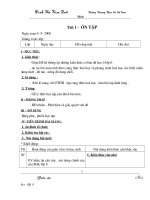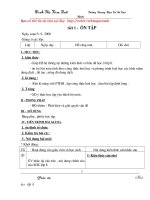Cao Bang THCS 02 HoangChiHuongCIRTICALCREATIVETHINKING
Bạn đang xem bản rút gọn của tài liệu. Xem và tải ngay bản đầy đủ của tài liệu tại đây (37.9 KB, 2 trang )
Cao Bằng -THCS 02 - Hồng_Chí_Hướng_CIRTICAL_&_CREATIVE_THINKING
In Vietnamese Curriculum, students develop capability in critical and creative
thinking as they learn to generate and evaluate knowledge, clarify concepts and ideas,
seek possibilities, consider alternatives and solve problems. Critical and creative
thinking involves students thinking broadly and deeply using skills, behaviours and
dispositions such as reason, logic, resourcefulness, imagination and innovation in all
learning areas at school and in their lives beyond school.
Thinking that is productive, purposeful and intentional is at the centre of effective
learning. By applying a sequence of thinking skills, students develop an increasingly
sophisticated understanding of the processes they can use whenever they encounter
problems, unfamiliar information and new ideas. In addition, the progressive
development of knowledge about thinking and the practice of using thinking
strategies can increase students’ motivation for, and management of, their own
learning. They become more confident and autonomous problem-solvers and
thinkers.
Responding to the challenges of the twenty-first century – with its complex
environmental, social and economic pressures – requires young people to be creative,
innovative, enterprising and adaptable, with the motivation, confidence and skills to
use critical and creative thinking purposefully.
This capability combines two types of thinking: critical thinking and creative
thinking. Though the two are not interchangeable, they are strongly linked, bringing
complementary dimensions to thinking and learning.
Critical thinking is at the core of most intellectual activity that involves students
learning to recognise or develop an argument, use evidence in support of that
argument, draw reasoned conclusions, and use information to solve problems.
Examples of critical thinking skills are interpreting, analysing, evaluating, explaining,
sequencing, reasoning, comparing, questioning, inferring, hypothesising, appraising,
testing and generalising.
Creative thinking involves students learning to generate and apply new ideas in
specific contexts, seeing existing situations in a new way, identifying alternative
explanations, and seeing or making new links that generate a positive outcome. This
includes combining parts to form something original, sifting and refining ideas to
discover possibilities, constructing theories and objects, and acting on intuition. The
products of creative endeavour can involve complex representations and images,
investigations and performances, digital and computer-generated output, or occur as
virtual reality.
Concept formation is the mental activity that helps us compare, contrast and classify
ideas, objects, and events. Concept learning can be concrete or abstract and is closely
allied with metacognition. What has been learnt can be applied to future examples. It
underpins the organising elements.
Dispositions such as inquisitiveness, reasonableness, intellectual flexibility, openand fair-mindedness, a readiness to try new ways of doing things and consider
alternatives, and persistence promote and are enhanced by critical and creative
thinking.
This method shows where Critical and Creative Thinking has been identified in
learning area content descriptions and elaborations.
Think locally, act globally problem solving with mass media theme. Take a critical,
creative approach English experience in class, in the world beyond for us and for
them the sky is limit.









